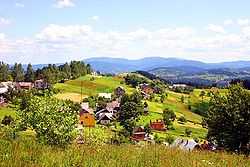Koniaków
| Koniaków | ||
|---|---|---|
| Village | ||
 | ||
| ||
 Koniaków | ||
| Coordinates: 49°33′6.15″N 18°56′26.94″E / 49.5517083°N 18.9408167°E | ||
| Country | Poland | |
| Voivodeship | Silesian | |
| County | Cieszyn | |
| Gmina | Istebna | |
| Government | ||
| • Mayor | Teresa Stańko | |
| Area | 14.69 km2 (5.67 sq mi) | |
| Elevation | 700 m (2,300 ft) | |
| Population (2010) | 3,595 | |
| • Density | 240/km2 (630/sq mi) | |
| Time zone | CET (UTC+1) | |
| • Summer (DST) | CEST (UTC+2) | |
| Postal code | 43-474 | |
| Car plates | SCI | |
![]() Koniaków (help·info) is a village in Beskid Śląski mountain range in Cieszyn County, Silesian Voivodeship, southern Poland. It is the highest elevated village in Silesian Beskids and lies in the historical region of Cieszyn Silesia. The village is primarily known for its tradition of intricate lace-making.
Koniaków (help·info) is a village in Beskid Śląski mountain range in Cieszyn County, Silesian Voivodeship, southern Poland. It is the highest elevated village in Silesian Beskids and lies in the historical region of Cieszyn Silesia. The village is primarily known for its tradition of intricate lace-making.
Koniaków lace
The tradition of lace-making in Koniaków is more than 150 years old.[1] Koniaków laces are handmade by crocheting cotton thread, using motifs inspired by nature. Lace motifs are worked separately, then connected to form larger pieces. The lace additions began appearing in pillows, shirts, blouses, and tablecloths around 1900.
Real fame was brought to Koniaków by lace tablecloths and table runners, which reached the tables of kings, aristocrats, and bishops. One was prepared for Queen Elizabeth II and another for Pope John Paul II. There are many examples of Koniaków lace lying on altars in Poland and other countries.[1]
Lace-making became subject to anger and disapproval in 2003, dividing the small Koniaków society, when some young lace makers started to make underwear out of Koniaków lace. Some elders in Koniaków view this activity as a disgrace upon an ancient and respectful profession; however, the new twist on Koniaków lace was a big success.
Koniaków lingerie is a byproduct of the lace-making tradition in the village. Although traditional lace has always been a village staple for industry,it wasn't until lace makers turned their knitting needles to crafting g-strings, thongs and other lingerie items that the village had its products become more and more popular.
Understanding that the Polish political system went through upheaval after the fall of communism in 1989, the $1,000 tablecloths became much harder to sell. Although considered heirlooms and taking more than a week to craft, tablecloths and doilies weren't bringing in enough money for the village lace makers, which affected all aspects of life.
References
- Bhatti, Jabeen (June 4, 2004). "Polish lace makers at odds over recent switch to G-strings". The Wall Street Journal.
| Wikimedia Commons has media related to Koniaków. |
| |||||||||||
Coordinates: 49°33′6.15″N 18°56′26.94″E / 49.5517083°N 18.9408167°E


